You searched for: FACEBOOK代全世界推广开户【TG飞机:@bapingseo】谷歌seo网站推荐【TG电报:@bapingseo】尼日利亚做广告【Telegram:@bapingseo】128棋牌下载hi合乐888手机?20220706k6BsJ9.html
<< Previous | Displaying results 251-300 of 1613 for "FACEBOOK代全世界推广开户【TG飞机:@bapingseo】谷歌seo网站推荐【TG电报:@bapingseo】尼日利亚做广告【Telegram:@bapingseo】128棋牌下载hi合乐888手机?20220706k6BsJ9.html" | Next >>
-
Bela Weichherz Diary Entry
Timeline EventJanuary 24, 1931. On this date, Bela Weichherz wrote in a diary about his daughter. All of the family would perish in the Holocaust.
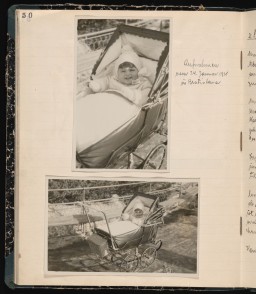
-
Peter Philipps
ID CardPete grew up in Essen, a major industrial city on Germany's Ruhr River. His father worked as a cattle hide dealer for an international trading company in nearby Muehlheim. His mother was a designer for a fashionable women's dress shop. Pete, his younger twin brothers, and parents lived together in an apartment. 1933–39: Pete had barely passed his first birthday when the Nazis came to power. His father realized the danger that now faced Jews in Germany, and the family left for Prague, Czechoslovakia, in…
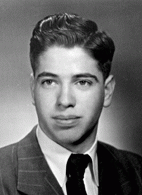
-
Reidar Dittmann
ID CardReidar was the third of four sons born to religious Lutheran parents in a small seafaring and whaling town along the Norwegian coast. Reidar's father was a civil servant. Reidar attended public school and dreamed of becoming a musician. 1933-39: Although Reidar was not interested in politics, he sympathized with his Jewish neighbors who had come as refugees from Germany. In fall 1939 he was saddened when Germany attacked Poland and the USSR attacked Finland. Several days later, his oldest brother passed…

-
Miso Vogel
ID CardMiso came from a religious family in a small village in Slovakia, where his father was a cattle dealer. He was the eldest of five children. When Miso was 6 his family moved to Topol'cany, where the children could attend a Jewish school. Antisemitism was prevalent in Topol'cany. When Miso played soccer, it was always the Catholics versus the Jews. 1933-39: In 1936 Miso had his bar mitzvah and was considered a man. His grandparents traveled 50 miles for it; he was so happy they were all together. In March…
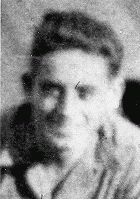
-
Karl Gorath
ID CardKarl was born in the small town of Bad Zwishenahn in northern Germany. When he was 2, his family moved to the port of Bremerhaven. His father was a sailor and his mother became a nurse in a local hospital. After his father died, Karl continued to live with his mother. Karl was 20 when he began training as a deacon at his parish church. 1933-39: Karl was 26 when his jealous lover denounced him and he was arrested at his house under paragraph 175 of the criminal code, which defined homosexuality as an…
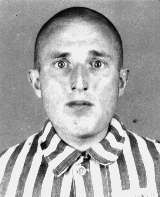
-
Isachar Herszenhorn (Irving Horn)
ID CardIsachar was born to a Jewish family in the Polish city of Radom, approximately 75 miles south of Warsaw. The city was the center of Poland's leather-tanning industry. Isachar's father worked as a salesman for a nearby tanning factory. His father was a successful salesman and the family lived comfortably. 1933-39: During registration for Isachar's first-grade class in 1934, a Jewish boy was pushed down the stairs. When his mother confronted the principal about the incident, all he said was that the boy had…

-
Jozef Tiso
ArticleJozef Tiso was a Slovak politician and a Roman Catholic priest. From 1939 to 1945, he was the president of the Slovak Republic, one of Nazi Germany’s allies.
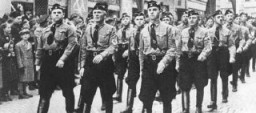
-
Adolf Hitler: 1919-1924
ArticleAdolf Hitler established himself as absolute Führer, or leader, of the Nazi Party by 1921. Learn more about Hitler in the years 1919-1924.

-
Adolf Hitler: 1930-1933
ArticleUnder Adolf Hitler's leadership, the Nazi regime was responsible for the mass murder of 6 million Jews and millions of other victims. Learn about Hitler in the years 1930-1933.
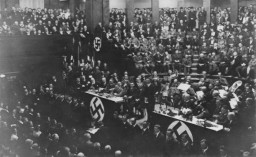
-
Ben Ferencz and the Fight for International Justice
ArticleBen Ferencz investigated and prosecuted Nazi crimes and devoted his career to creating an international system of justice. Learn about his activities and impact.

-
Pastor Martin Niemöller
PhotoPastor Martin Niemöller at his desk in his home. Berlin, Germany, ca. 1936.
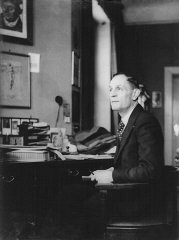
-
Portrait of Tsewie Herschel taken while he was living in hiding
PhotoPortrait of Tsewie Herschel seated in a chair, taken while he was living in hiding. Oosterbeek, the Netherlands, 1943–1944. Tsewie never knew his parents. Born in December 1942, he was hidden with the de Jong family in April 1943. That July, his parents were deported from the Netherlands to the Sobibór killing center. The de Jongs renamed Tsewie "Henkie," raised him as a Christian, and treated him as their son. Tsewie learned about his origins from his paternal grandmother, who reclaimed him…

-
Heinrich Himmler: Key Dates
ArticleHeinrich Himmler was the leader of the dreaded SS of the Nazi Party from 1929 until 1945. Learn more about key dates in the life of Heinrich Himmler.

-
Foundations of the Nazi State
ArticleFollowing Hitler's appointment as chancellor, the Nazis began laying the foundations of a state based on racist and authoritarian principles and the elimination of individual freedoms.
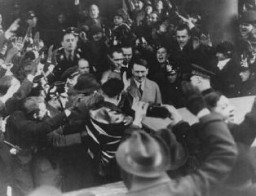
-
Rwanda: The First Conviction for Genocide
ArticleThe first conviction for the crime of genocide came after the 1994 genocide in Rwanda, when Jean-Paul Akayesu was found guilty of genocide and crimes against humanity.
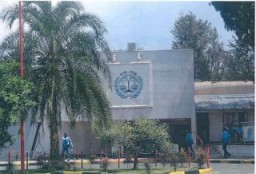
-
Villiam Krausz sits with a doll and a teddy bear shortly before the family went into hiding
PhotoBenjamin Kedar (born Villiam Krausz) sits with a doll and a teddy bear shortly before his family went into hiding. Villiam's parents married in Prague and settled in Nitra, Slovakia. They worked as physicians. They had a daughter, Helen, in 1934, and Villiam in 1938. In 1942 the family relocated to a nearby village until September 1944. At that point, they went into hiding with Slovak peasants to avoid deportation to Auschwitz. Villiam, his sister, and his parents survived the…
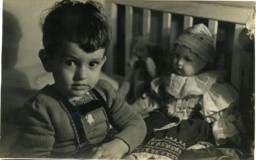
-
Raphael Lemkin Dies
Timeline EventAugust 28, 1959. On this date, Raphael Lemkin died. He coined the term "genocide" and worked tirelessly for the term to become international law.
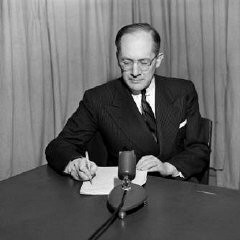
-
Silvio Ortona
ArticleRead the Jewish Partisan Educational Foundation's short biography of Silvio Ortona.

-
Frank Blaichman (Jewish Partisan Educational Foundation biography)
ArticleRead the Jewish Partisan Educational Foundation's short biography of Frank Blaichman.
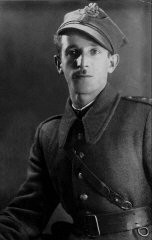
-
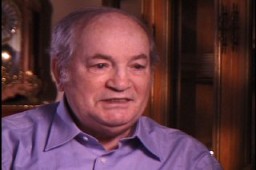
-
Miles Lerman (Jewish Partisan Educational Foundation biography)
ArticleRead the Jewish Partisan Educational Foundation's short biography of Miles Lerman.
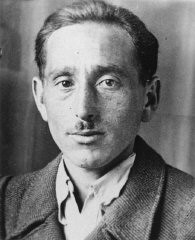
-
Samuel Levi
ArticleRead the Jewish Partisan Educational Foundation's short biography of Samuel Levi.
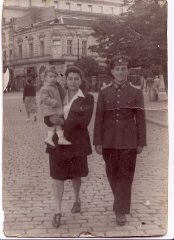
-
Gideon Frieder
ArticleExplore Gideon Frieder’s biography and learn about his experiences as a child during the Holocaust in Slovakia.
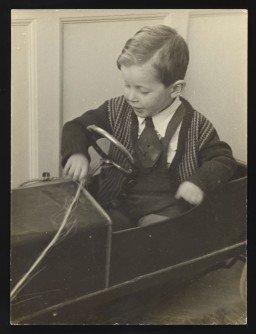
-
Background: Jurists' Trial Verdict
ArticleThe Justice Case, or Jurists’ Trial, of the Subsequent Nuremberg Proceedings tried members of the German justice administration. Browse excerpts from the verdict.
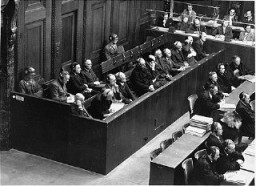
-
Abraham Malnik
ID CardAbraham was born to a Jewish family in Kovno, a city picturesquely situated at the confluence of two rivers. With an opera company, chic stores and lively nightclubs, it was often called "Little Paris." The city had a large Jewish community of 38,000 and was known for its extensive Hebrew school system. Abraham's father was a barber, and his mother was a beautician. 1933-39: When Abraham was a kid his family used to go to his grandparents' house for Sunday dinner. In the winter they would take a…
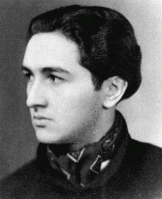
-
Aaron Lejzerowicz
ID CardAaron was one of four children born to a Jewish family in the northeastern Polish town of Zdzieciol. His father was a shoemaker and, along with a business partner, he also ran a shoe store in the town. Aaron attended a private Jewish school, where he studied the Polish language and history as well as Jewish history and Hebrew. 1933-39: On September 1, 1939, Germany invaded Poland. Three weeks later, Poland was partitioned between Germany and the Soviet Union [under the German-Soviet Pact]. Aaron and his…
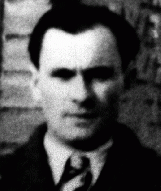
-
Julius (Julo) Levin
ID CardJulo was born to a Jewish family in the city of Stettin in northeastern Germany. From an early age Julo showed an interest in art; at 6 he had collected more than 3,000 pictures. His family hoped he would become a businessman, but his interest in painting absorbed all his energy. In 1926 he graduated from art school and by 1931 he secured his first commission in Duesseldorf. 1933-39: Until the Nazis came to power in 1933, Julo was a highly regarded artist. The Nazis' strict interpretation of art, however,…

-
Shulim Saleschutz
ID CardShulim was the oldest of three children born to religious Jewish parents living in Kolbuszowa, a town in south central Poland. His father owned a wholesale general store in town, and was known in the region for his impressive strength. Shulim's mother tended to the house and cared for him, his brother, Shlomo, and his sister, Rozia. 1933-39: When Shulim was 9, the Germans invaded Poland. Polish soldiers on horses tried to fight against the German army, but they were no match against the tanks. After the…

-
Chuna Grynbaum
ID CardChuna was born in a small one-story house that served as both his family's residence and their tailor shop. He was the youngest of nine children born to religious Jewish parents. The family's tailor shop mostly served Starachowice's Catholic Poles. The work was often done in exchange for goods such as firewood or a sack of potatoes. 1933-39: Chuna's father died unexpectedly in June 1939. After returning from synagogue one day, his father lay down to rest. He asked Chuna to close the shade to darken the…

-
Natan Offen
ID CardNatan was one of four children born to religious Jewish parents. They lived in an apartment in Cracow's [Krakow] Podgorze district, a predominantly Jewish area on the southern bank of the Vistula River. Natan's father was a shoemaker until 1936, when he became a dealer in billiards equipment. His mother worked as a dressmaker. Natan and his siblings attended Polish public school. 1933-39: When Natan was 13 he built a crystal radio. Late at night, Natan and his father would listen to stations from all over…

-
Janos Geroe
ID CardJanos was the only child born to a Jewish family in the small agricultural city of Torokszentmiklos, about 65 miles southeast of Budapest. His father, who had a degree in pharmacology, joined his family's grain exporting business. 1933-39: In 1933, when Janos was 4 years old, his parents divorced. According to Hungarian law, Janos was to live with his mother until he was 7 and then return to his father. Janos moved with his mother to her hometown of Szentes, where he began studying at a religious primary…
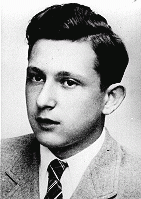
-
Shaye Rothkopf
ID CardShaye's town in the province of Lodz had a Jewish community that comprised almost one-third of the town's population. Shaye was very young when his father died during World War I. Afterwards, his grandparents helped to support his family. When Shaye was a teenager, his mother died. He and his siblings then lived with their grandparents. 1933-39: Swimming was Shaye's favorite pastime and he'd go with his friends to the banks of the Vistula River on every possible occasion. He worked in Lodz for a company…

-
Thomas Elek
ID CardThomas was born to a Jewish family who moved to Paris when he was 6. His father's outspoken criticism of the fascist government and his affiliation with the Hungarian Communist Party led to the family's expulsion from Hungary in 1930. With the help of his father, a professor of modern languages, Thomas quickly learned French and excelled in school. He had a special interest in poetry and music. 1933-39: Thomas's father often argued against fascism, and he was greatly disturbed when Hitler became the…
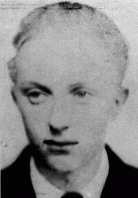
-
Fritz Silten
ID CardFritz was the youngest of two sons born to a Jewish family in the German capital of Berlin. In the late 1920s he earned a doctorate in chemistry and pharmacy. In 1931 he married Ilse Teppich, and in 1933 the couple had a daughter, Gabriele. 1933-39: Fritz worked in his father's pharmacy until 1938, when the Nazis forced them to sell the business for a fraction of its value to an "Aryan" German [Aryanization]. Leaving his parents behind was agonizing, but concern for the safety of his wife and daughter…
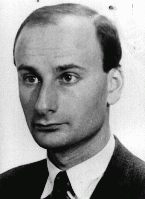
-
Adolf Hitler
ArticleAdolf Hitler, leader of the Nazi Party, aimed to eliminate Europe's Jews and other perceived enemies of Nazi Germany. Learn more.

-
Eichmann Trial
ArticleAdolf Eichmann, a pivotal figure in the implementation of the “Final Solution,” was put on trial in Jerusalem, Israel, in 1961. Learn about the trial and its legacies.

-
Alfred Dreyfus and the "Dreyfus Affair"
ArticleJewish military officer Alfred Dreyfus was wrongfully convicted of treason against France in 1894. The trial and ensuing events are known as the “Dreyfus Affair.” Learn more.
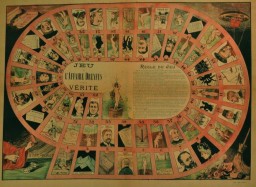
-
David Bayer
ArticleDavid Bayer lived in Kozienice, Poland. Explore his biography and learn about his experiences during World War II and the Holocaust.

-
Assessing Guilt
ArticleAfter WWII, prosecutors faced the challenge of assessing the guilt of propagandists whose words, images, and writings had supported Nazi brutality and mass murder.
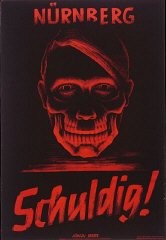
-
Reinhard Heydrich: In Depth
ArticleReinhard Heydrich, Reich Security Main Office chief, was one of the main architects of the “Final Solution," the Nazi plan to murder the Jews of Europe.
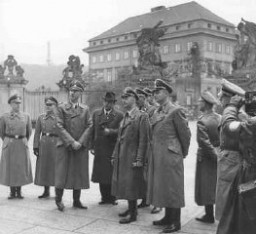
-
Israel Milkow
ID CardIsrael was born to a religious Jewish family living in the town of Slonim. He was called Yisroel by his Yiddish-speaking parents. Israel's father, Lazar Milkow, was a baker who supported his family on a meager income. 1937-39: Israel's grandparents and many of his mother's relatives lived in a nearby village called Kaslovchina. Each summer one of the Milkow boys was invited to stay in Kaslovchina with their Uncle Herschel who worked as a farmer and horse trader. In September 1939 Slonim became part of the…
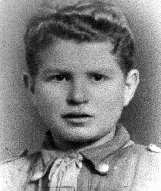
-
Tomas Kulka
ID CardTomas' parents were Jewish. His father, Robert Kulka, was a businessman from the Moravian town of Olomouc. His mother, Elsa Skutezka, was a milliner from Brno, the capital of Moravia. The couple was well-educated and spoke both Czech and German. They married in 1933 and settled in Robert's hometown of Olomouc. 1933-39: Tomas was born a year and a day after his parents were married. When Tomas was 3, his grandfather passed away and the Kulkas moved to Brno, which was his mother's hometown. On March 15,…

-
Wilhelm Kusserow
ID CardBorn at the beginning of World War I, Wilhelm was patriotically named after Germany's emperor, Wilhelm II. The eldest son, Wilhelm was raised a Lutheran, but after the war his parents became Jehovah's Witnesses and raised their children according to their faith. After 1931, their home in the rustic town of Bad Lippspringe became known as a center of Jehovah's Witness activity. 1933-39: The Kusserows were under close scrutiny by the Nazi police because Witnesses believed that their highest loyalty was to…

-
Frederick Dermer
ID CardFrederick was born to a Jewish family in the Austrian capital of Vienna. His father died when he was a baby, and he and his mother moved into an apartment with Frederick's widowed grandfather. As a young boy, Frederick attended a Viennese public school. 1933-39: Frederick was a rambunctious child. Once, when his grandfather was baby-sitting, Frederick used a silk lampshade as a "parachute," and jumped from the top of the wardrobe closet. That was the last time Frederick's grandfather would baby-sit.…

-
Alexander Bernstein
ID CardAlexander was one of six children born to a Jewish family in the Lithuanian village of Karchai. His father was a farmer. In nearby Janova, Alexander attended public school and also studied Hebrew and Jewish history in a religious school. In 1925 Alexander moved to Siauliai to attend secondary school. He lived there with his older sister. 1933-39: Alexander enrolled in university in Kovno, and entered the pharmacology department. After completing his degree, he returned to Siauliai and took a job in a…
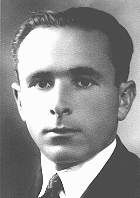
-
Henry Morgenthau Jr.
ArticleHenry Morgenthau Jr had a key role in creating and operating the War Refugee Board, a government agency tasked with rescuing and providing relief for Jews during the Holocaust.
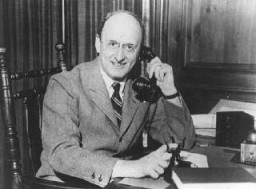
-
Vidkun Quisling on Trial in Norway for War Crimes
FilmVidkun Quisling headed the German-controlled government of Norway from 1942-1945. Because of his actions, his name became synonymous with Nazi collaboration.
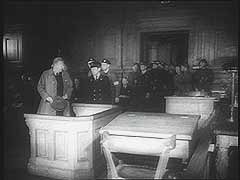
-
Mein Kampf
ArticleAdolf Hitler's Mein Kampf (My Struggle) is the best known and most popular Nazi text ever published with over 12 million copies sold from 1925 to 1945.
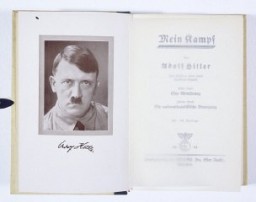
-
Beer Hall Putsch (Munich Putsch)
ArticleOn November 8–9, 1923, Hitler and the Nazi Party led an attempt to overthrow the German government. This attempted coup came to be called the Beer Hall Putsch.

